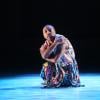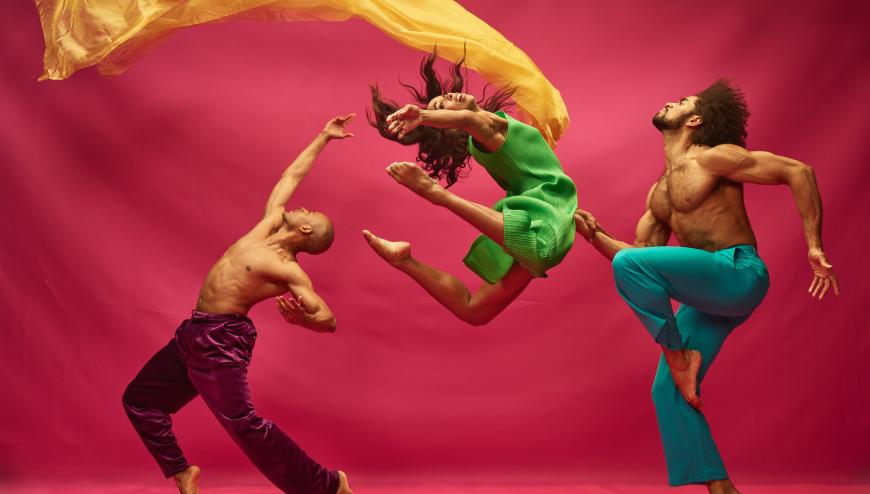
The legendary Alvin Ailey American Dance Theater, now 65 years old, opened for its annual run at Zellerbach Hall on Tuesday, April 11. Except for a year off during the pandemic, the company has performed in every Cal Performances season since 1968. This correspondent has been watching them 55 of those years, first in New York City, then here in the Bay Area, through all three artistic directors and scores of dancers. Keeping a dance company alive and thriving for six and a half decades is a miracle to celebrate, especially for one not in the Western European ballet lineage, and the Ailey dancers continue to make it worthwhile to see them live.
The week’s offerings on Program A are quite varied but mostly glimpses into the past. First up is Twyla Tharp’s Roy’s Joys, created in 1997 but only danced by the Ailey company since 2022. Employing a mix of Roy Eldridge jazz recordings from the 1940s and ’50s, some with vocals, the individual numbers constantly reshuffle steps and partners. The dancers are nothing less than spectacular both artistically and technically. While the bouncy, whimsical strutting and swooping is great fun, the overall choreography could benefit from some architectural structure. The sequences of steps, with more developmental shaping and broader imagination, would have given the performers something substantial to sink their teeth into. The material, drawn out over nine musical pieces, only dilutes Tharp’s own efforts.
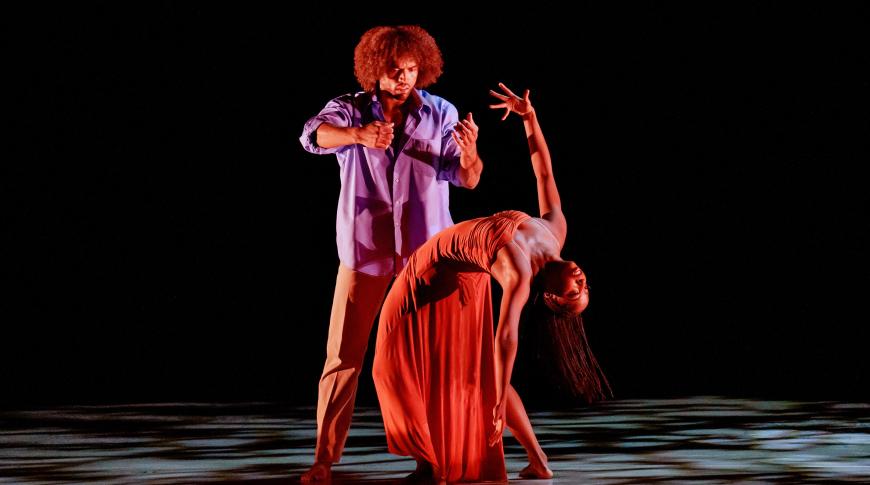
The middle section of the evening has two works by current Artistic Director Robert Battle. The first is Unfold (2007), inspired by the iconic soprano Leontyne Price. Ashley Mayeux, in a strapless orange gown, and Jeroboam Bozeman, in shirt and slacks, portray a couple who slowly reveal the many facets of their relationship over the course of Price’s rendition of “Depuis le jour” from Gustave Charpentier’s opera Louise. The dancers’ ability to move from intense passion or anger to touching intimacy and back again is testament to their unbelievable artistry.
For Four (2021) is Battle’s answer to the isolation that we all experienced during the pandemic. He lets a quartet of cats out of the bag to create an exuberant and rare tour de force. The music of Wynton Marsalis underscores the lightning footwork, tornado-powered turns, and catapulted jumps that appear effortless. Four dancers seem like a dozen as they take their black jackets on and off while taking turns in the spotlight or joining with the others in duos and trios.
Battle shows in both of his works that he doesn’t need to make a piece very long — just long enough that the viewer gets the point. He must have consciously or unconsciously heeded Doris Humphrey’s advice from her book The Art of Making Dances that “all dances are too long”; perhaps he could apply the same standard to all the pieces that appear in the company’s repertoire.

Alvin Ailey’s perennial favorite, Revelations, concludes the evening. Ailey’s memories of growing up in the South and attending church services in Texas resulted in this homage to the rich cultural heritage of African Americans. Even after seeing it close to 80 times, this correspondent still finds new details to appreciate in the work danced to traditional Black spirituals and hymns.
Ghrai DeVore-Stokes and Bozeman bring a delicate tenderness to “Fix Me, Jesus” with their seamless rapport. “I Wanna Be Ready” offers another interpretation, by Yannick Lebrun, that is less about muscular strength, more about the power of spiritual belief. “Sinner Man” is always a crowd-pleaser, and Christopher R. Wilson, Jau’mair Garland, and Patrick Coker are wicked good. By the time the whole company finishes “Rocka My Soul” with the men on their knees, the audience is on its feet screaming and shouting for the obligatory encore.
The next evening (Wednesday, April 12), Program B showed an even balance of old and new works. Choreographer Jamar Roberts is not unknown to the local dance scene as his ballet Resurrection was commissioned by San Francisco Ballet for its “next@90” festival earlier this year. His atmospheric duet In a Sentimental Mood (2022) takes the stage with music by Duke Ellington and Rafiq Bhatia.
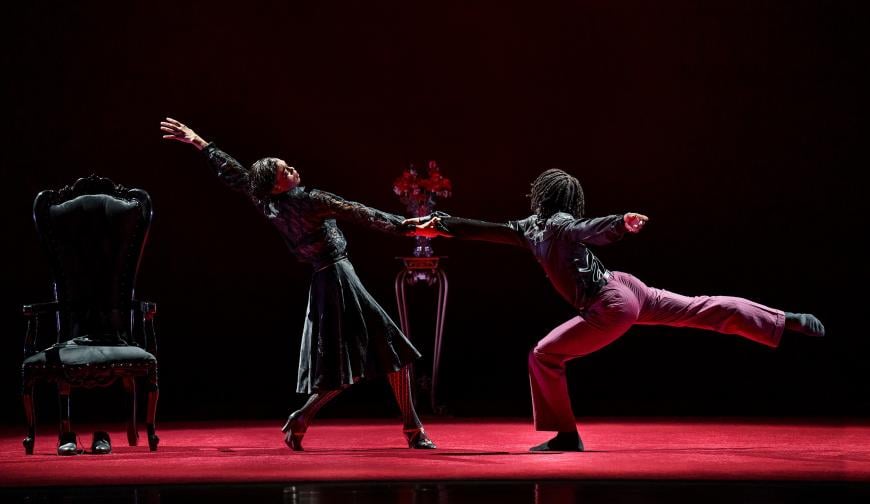
DeVore-Stokes, as a stylish woman in a whiter-than-white coat, white brimmed hat, red print scarf, and bright red gloves, walks across the front of the stage. She hesitates with indecision. She enters a home as a lamp lights and takes off her coat, hat, and gloves, revealing a black dress. Waiting is her partner, Chalvar Monteiro. The ensuing lengthy pas de deux is a study in the shapes and colors love can take on. Both dancers are riveting and excellent on every level. At the very end, she walks away, shunning the single flower he offers her.
Paul Taylor was one of the most versatile choreographers, creating in a broad spectrum of styles, and the Ailey company has performed his Airs and Arden Court in previous seasons. With Belén Indhira Pereyra and Coker dancing his DUET, another of the choreographer’s facets is on display. The recurring theme of this program is love, and this work shows it literally by the end. The Haydn score — the Largo from The Seven Last Words of Christ — is the perfect accompaniment for the purity of the choreography: old-fashioned modern dance, without bravura gimmicks or over-the-top emotion. Pereyra and Coker are in synch forming an array of forms and phrases with their bodies, entwined at last in the image of an actual heart that gently pulsates. Perfection.
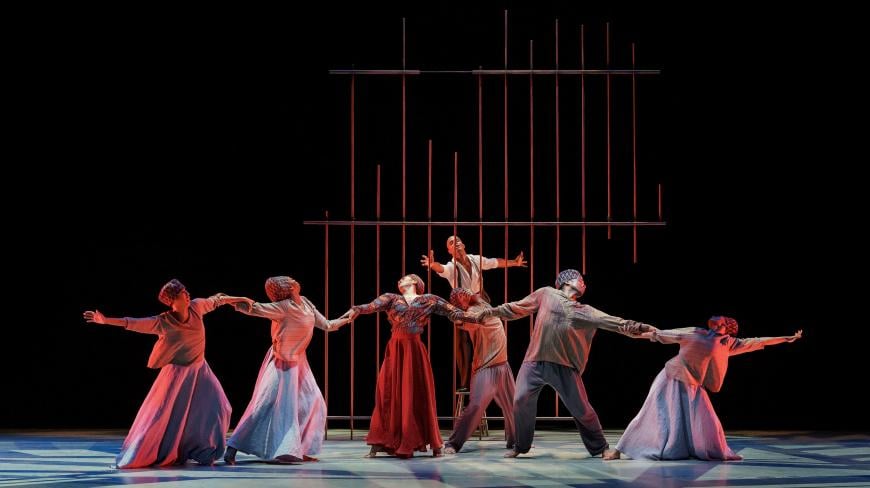
Survivors, choreographed by Ailey and Mary Barnett in 1986 and revived in a new production in 2022, is having its Bay Area premiere. The work is dedicated to Winnie and Nelson Mandela; Ailey was inspired by their determination, which in turn inspires the survivor in all of us. The ideas about human nature, justice, and liberty are definitely worth exploring, and the dancers are all more than up to the task technically and emotionally. However, the choreography is largely drawn from the same vocabulary as Revelations and hinders attempts to dig deeper into the subject due to that association. The dancers often work in unison, akin to a Greek chorus, which is powerful. The set design is a group of bars hanging above center stage. Toward the end, they are lowered, forming a jail cell incarcerating the lead man.
Kyle Abraham’s Are You in Your Feelings? (2022) is the closing piece. The structure of it is very similar to Tharp’s Roy’s Joys. Take a bunch of songs and choreograph to them. But while Tharp sticks with one composer, Abraham’s choices are from 11 different sources. Unfortunately, the result is also pretty much the same, with one exception. Yes, it’s energetic, joyful, and fun to watch, and the dancers are terrific. But Abraham does not give them truly juicy steps that challenge their considerable abilities. There is a lot of swinging arms and making gestures while standing in one place. Abraham doesn’t seem to have the vocabulary to work with the performers’ best versions of themselves. Maybe in the future he will develop that aspect when working with gifted dancers.



